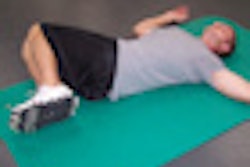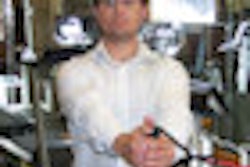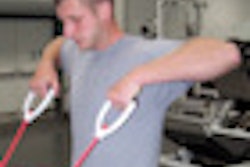Despite the use of ergonomically designed ultrasound equipment, researchers at Yale University in New Haven, CT, have found that 96% of their female sonographers experienced some type of musculoskeletal symptom within a 12-month time frame.
The study, conducted through the school's Occupational and Environmental Medicine Program, found that shoulder (73%) and lower back (69%) symptoms were the most common aliments, followed by wrist and hand issues (54%).
"All of these people are experiencing some discomfort, some in multiple areas, some in one specific area," said Dr. James J. Hill, assistant professor of medicine at Yale and lead study author. "Unless something changes, this group is going to move on to have career-ending injuries."
The study is published in the September issue of Work: A Journal of Prevention, Assessment, and Rehabilitation (2009, Vol. 33:2, pp. 181-189).
Ergonomic equipment
The researchers noted that ultrasound equipment manufacturers have made a concerted effort in recent years to make sonographer workstations more ergonomically friendly, with height-adjustable keyboards, monitors, and control panels; lightweight transducers that facilitate a palmar grip; and voice-activated controls. But musculoskeletal problems persist.
"Even with newer machines, ergonomically designed carts, and different transducers, we are still seeing very high rates of symptoms in our population," Hill said. "At face value, it is shocking, but as we got into it, we were overestimating the impact just changing the equipment would make in the work experience."
Twenty-six Yale sonographers completed a survey and interviews in April and May 2006. The female sonographers had a mean age of 36.9 years, with a mean career duration of 9.2 years and mean job duration of 6.4 years. Six sonographers worked between 24 and 32 hours per week, 14 sonographers worked between 36 and 40 hours weekly, and four sonographers worked more than 40 hours per week.
(Two male sonographers at Yale were excluded from the study, because of their small number and the differences between males and females in terms of grip strength and anthropometric measurements.)
Four-part questionnaire
The research included a four-part written questionnaire on the sonographers' demographic information, such as age, gender, and hand dominance. Researchers also collected anthropometric measurements, such as hand length and span, forward reach, height, weight, and body mass index, along with grip strength. There also was a review of occupational health records for previous treatment or more serious musculoskeletal injury.
The survey also asked questions about both physical and psychological job demands and the sonographers' work pace, the importance of avoiding mistakes, the presence of conflicting work demands, and the degree of control over how and when a task is completed.
"Those things also are ergonomic, but they are things that can't be manufactured; they are how your organization runs," Hill said. "We were finding that it was difficult for the practitioner to change their day-to-day job. In some workplaces, if you are having a bad day or something hurts, you can shift the responsibilities to someone else and the team takes care of the problem. In this population, there isn't a break on some levels."
Abdominal girth
The researchers also measured abdominal girth of the sonographers to determine how close they could get to a keyboard or a patient. The current advice for sonographers is to angle one's shoulder 10° to 60° toward the patient to avoid any undue stress on the joint while scanning. If that angle cannot be maintained due to abdominal girth, Hill said, the sonographer could develop shoulder symptoms.
"It looked like people who had a larger abdominal girth were more at risk in general for some musculoskeletal symptoms," Hill said. "Why that is, we can hypothesize all day. With our measures of forward reach and how close we can position to patients, that may be one factor, but it is hard to say."
The results found that 25 of the 26 female sonographers reported at least one musculoskeletal symptom, with shoulders, lower back, wrist and hand, and neck conditions among the most common complaints. Only one sonographer reported no symptoms.
|
||||||||||||||||||||
| *25 of 26 sonographers reported at least one musculoskeletal complaint Source: Yale University and Work |
As for the causes of musculoskeletal problems, the study cited job strain, time on the job, work pace and variability, and time spent standing as several variables for the musculoskeletal symptoms.
One dilemma the study uncovered is that by reducing the risk factors for one anatomic location, a sonographer likely is increasing the risk of pain in another area. For example, if a sonographer changes his or her hand and wrist position to alleviate discomfort, the adjustment will add pressure to the neck or back, causing another symptom.
"We can tell them to maintain a certain position of the wrist, but they still have to do that same motion," Hill said. "They will simply shift the burden to the shoulder or to the back."
So what can sonographers do to minimize their risk of injury? Periodic breaks and stretching exercises are a start, Hill said, but there is no magic bullet. "Unless you get to the root or nature of the problem, these are technically demanding studies with a lot on the line," he said.
He added that the results "beg the question: Are we hitting the end of how well we can design the equipment? We may have made all the gains we can. Then the question becomes: What are we doing with the job task? The best ergonomic equipment in the world for someone doing 30 diagnostic studies a day is not going to help them."
Among the study's recommendations is teaching safer scanning positions, especially in initial training sessions, with increased emphasis on shoulder positions. The authors also advocated the possible redesign of transducers and improvements in the work environment.
Physicians beware
Musculoskeletal symptoms are not exclusive to sonographers and can occur among physicians, emergency medical responders, nurses, and firefighters, Hill said, as they "tend to neglect their own symptoms as they are helping everyone else."
He believes that physicians might be the next group to experience musculoskeletal symptoms because they increasingly use ultrasound for office diagnostics and joint injections. "Are they going into this field blind?" Hill queried. "And will we see an increase in physician injuries as they incorporate ultrasound in their daily practice?"
With an estimated 41,280 diagnostic medical sonographers working in the U.S., according to the U.S. Bureau of Labor Statistics, the Yale researchers plan to gather more anthropometric data to help vendors and engineers design future ultrasound equipment.
"You would rather engineer a solution and put in controls," Hill said. "If you depend on the individual to do things safely, that is usually where you have the most problems."
By Wayne Forrest
AuntMinnie.com staff writer
September 29, 2009
Related Reading
A small hospital's experience mitigating sonographer injuries, July 14, 2009
Lean principles and ergonomics aid imaging management, April 30, 2008
U.S. government issues update on WRMSDs in sonography, December 25, 2006
Tackling ergonomic issues in sonography, September 13, 2004
Managing ultrasound ergonomics, March 26, 2004
Copyright © 2009 AuntMinnie.com



















